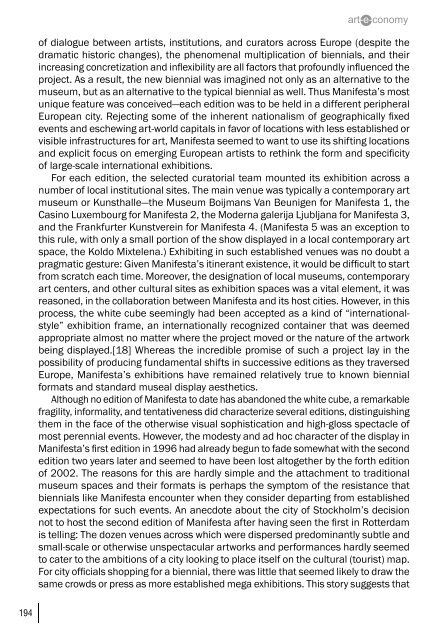art-e-conomy _ reader - marko stamenkovic
art-e-conomy _ reader - marko stamenkovic
art-e-conomy _ reader - marko stamenkovic
You also want an ePaper? Increase the reach of your titles
YUMPU automatically turns print PDFs into web optimized ePapers that Google loves.
194<br />
of dialogue between <strong>art</strong>ists, institutions, and curators across Europe (despite the<br />
dramatic historic changes), the phenomenal multiplication of biennials, and their<br />
increasing concretization and inflexibility are all factors that profoundly influenced the<br />
project. As a result, the new biennial was imagined not only as an alternative to the<br />
museum, but as an alternative to the typical biennial as well. Thus Manifesta’s most<br />
unique feature was conceived—each edition was to be held in a different peripheral<br />
European city. Rejecting some of the inherent nationalism of geographically fixed<br />
events and eschewing <strong>art</strong>-world capitals in favor of locations with less established or<br />
visible infrastructures for <strong>art</strong>, Manifesta seemed to want to use its shifting locations<br />
and explicit focus on emerging European <strong>art</strong>ists to rethink the form and specificity<br />
of large-scale international exhibitions.<br />
For each edition, the selected curatorial team mounted its exhibition across a<br />
number of local institutional sites. The main venue was typically a contemporary <strong>art</strong><br />
museum or Kunsthalle—the Museum Boijmans Van Beunigen for Manifesta 1, the<br />
Casino Luxembourg for Manifesta 2, the Moderna galerija Ljubljana for Manifesta 3,<br />
and the Frankfurter Kunstverein for Manifesta 4. (Manifesta 5 was an exception to<br />
this rule, with only a small portion of the show displayed in a local contemporary <strong>art</strong><br />
space, the Koldo Mixtelena.) Exhibiting in such established venues was no doubt a<br />
pragmatic gesture: Given Manifesta’s itinerant existence, it would be difficult to st<strong>art</strong><br />
from scratch each time. Moreover, the designation of local museums, contemporary<br />
<strong>art</strong> centers, and other cultural sites as exhibition spaces was a vital element, it was<br />
reasoned, in the collaboration between Manifesta and its host cities. However, in this<br />
process, the white cube seemingly had been accepted as a kind of “internationalstyle”<br />
exhibition frame, an internationally recognized container that was deemed<br />
appropriate almost no matter where the project moved or the nature of the <strong>art</strong>work<br />
being displayed.[18] Whereas the incredible promise of such a project lay in the<br />
possibility of producing fundamental shifts in successive editions as they traversed<br />
Europe, Manifesta’s exhibitions have remained relatively true to known biennial<br />
formats and standard museal display aesthetics.<br />
Although no edition of Manifesta to date has abandoned the white cube, a remarkable<br />
fragility, informality, and tentativeness did characterize several editions, distinguishing<br />
them in the face of the otherwise visual sophistication and high-gloss spectacle of<br />
most perennial events. However, the modesty and ad hoc character of the display in<br />
Manifesta’s first edition in 1996 had already begun to fade somewhat with the second<br />
edition two years later and seemed to have been lost altogether by the forth edition<br />
of 2002. The reasons for this are hardly simple and the attachment to traditional<br />
museum spaces and their formats is perhaps the symptom of the resistance that<br />
biennials like Manifesta encounter when they consider dep<strong>art</strong>ing from established<br />
expectations for such events. An anecdote about the city of Stockholm’s decision<br />
not to host the second edition of Manifesta after having seen the first in Rotterdam<br />
is telling: The dozen venues across which were dispersed predominantly subtle and<br />
small-scale or otherwise unspectacular <strong>art</strong>works and performances hardly seemed<br />
to cater to the ambitions of a city looking to place itself on the cultural (tourist) map.<br />
For city officials shopping for a biennial, there was little that seemed likely to draw the<br />
same crowds or press as more established mega exhibitions. This story suggests that


